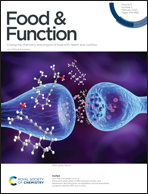The proteomic profiling of multiple tissue damage in chickens for a selenium deficiency biomarker discovery†
Abstract
Over the past decades, substantial advances have been made in both the early diagnosis and accurate prognosis of numerous cancers because of the impressive development of novel proteomic strategies. Selenium (Se) is an essential trace element in humans and animals. Se deficiency could lead to Keshan disease in humans, mulberry heart disease in pigs and damage of tissues including cardiac injury, apoptosis in the liver, reduction in the immune responses in spleen and cerebral lesions in chickens. However, it is well know that plasma biomarkers are not specific and also show alterations in various diseases including those caused by Se deficiency. Therefore, new definition biomarkers are needed to improve disease surveillance and reduce unnecessary chicken losses due to Se deficiency. To identify new biomarkers for Se deficiency, we performed exploratory heart, liver, spleen, muscle, vein, and artery proteomic screens to further validate the biomarkers using Venn analysis, GO enrichment, heatmap analysis, and IPA analysis. Based on the bioinformatics methods mentioned above, we found that differentially expressed genes and proteins are enriched to the PI3K/AKT/mTOR signal pathway and insulin pathway. We further used western blot to detect the expression of proteins related to the two pathways. Results showed that the components of the PI3K/AKT/mTOR signal pathway were definitely decreased in heart, liver, spleen, muscle, vein and artery tissues in the Se deficient group. Expression IGF and IGFBP2 of the insulin pathway were differentially increased in the heart, liver, and spleen in Se deficient group samples and decreased in muscle and artery. In conclusion, 5 proteins, namely PI3K, AKT, mTOR, IGF, and IGFBP2, were differentially expressed, which could be potentially useful Se deficient biomarkers. In the present study, proteomic profiling was used to elucidate protein biomarkers that distinguished Se deficient samples from the controls, which might provide a new direction for the diagnosis and targeted treatment induced by Se deficiency in chickens.

- This article is part of the themed collection: Food & Function Recent HOT articles


 Please wait while we load your content...
Please wait while we load your content...